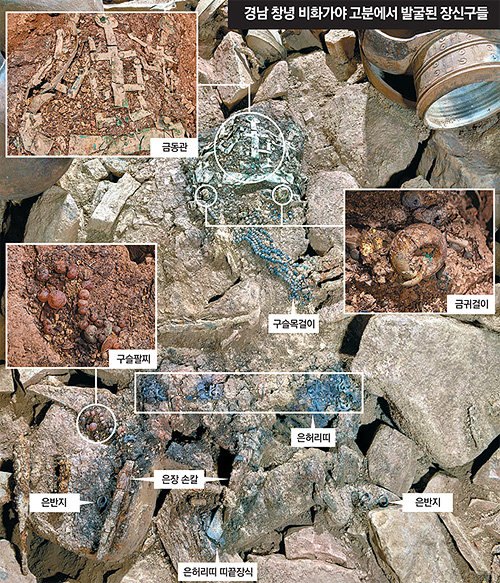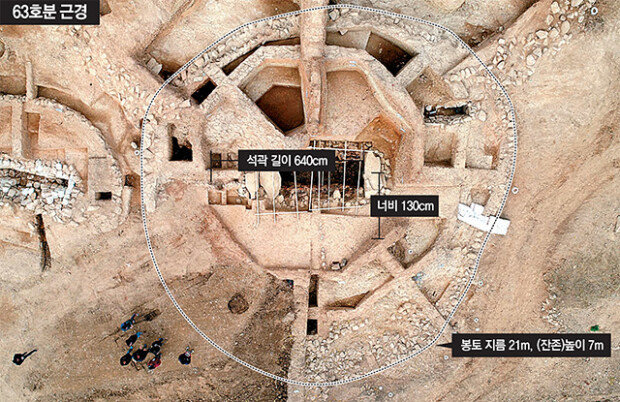Jewelry Bihwa Gaya’s tomb is excavated for the first time in 1,500 years
Jewelry Bihwa Gaya’s tomb is excavated for the first time in 1,500 years
Posted October. 29, 2020 07:40,
Updated October. 29, 2020 07:40


The Changnyeong Gyo-dong and Songhyeon-dong tumuli from the Gaya era were heavily robbed after the Japanese colonial period. However, one of the tumuli that remained intact was excavated to reveal a pile of jewelry.
The Gaya National Research Institute of Cultural Heritage of the Cultural Heritage Administration announced on Thursday that a bronze crown, gold earrings, and beaded necklaces have been discovered from the tumulus No. 63 of the Gyo-dong II tumuli in Changnyeong, South Gyeongsang Province. Other than the lack of shoes, it is similar to an ancient Silla tomb in Hwangnam-dong, Gyeongju, North Gyeongsang Province, which was excavated last month, in that jewelry to be worn on various parts of the body were found.
The tumulus No. 63 of the Gyo-dong II tumuli is estimated to have been created around the mid-fifth century. The tumulus No. 39, which is located two meters north from it, is ruined by tomb robbery with a plastic bag for bread, a rubber washbasin, and a bucket scattered inside. Bihwa Gaya’s tumuli in Changnyeong have a structure that is easy to enter through top-covering rocks, hence exposing them to robbery. So far only the fragments of a bronze crown or some pieces of jewelry were found while broader information about Bihwa Gaya’s relics remained unknown.
The relics discovered recently are extravagant. A 21.5-centimeter-tall bronze crown was found near the head. Tree branch-shaped ornaments are placed in three layers and beads made of jade and gilt bronze are hung below the headband. A piece of fabric that seems to be part of an official hat was also discovered in a coffin.
Another noteworthy feature is that the structure of the tumulus and excavated earthenware follow the typical Gaya style while jewelry is similar to that of Silla. “Perhaps, Bihwa Gaya, which was located east of the Nakdong River, interacted frequently with Silla,” said Yang Sook-ja, the head of the art and science research team. “However, it is likely to be that of Gaya based on the archeological change of tumulus structure to be more conservative.”
Min Kim kimmin@donga.com
Headline News
- N. Korea launches cyberattacks on S. Korea's defense companies
- Major university hospital professors consider a day off each week
- Italy suffers from fiscal deficits from ‘Super Bonus’ scheme
- Inter Milan secures 20th Serie A title, surpassing AC Milan
- Ruling and opposition prioritize spending amid tax revenue shortfalls







